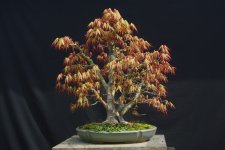Yannick81
Sapling
Hello,
I am new to bonsai. Have tried a couple of things since maybe 4 years and encounter difficulties quite regulary.
I bought an Acer Palmatum at a supermarket last spring and wired all major branches. Unfortunately one thin brannch has not produced any foilage this season and is starting to dry out. The wire was too tight for a period of around 7 months.
My question is if there is a chance it will recover. Seems to me that the tree is producing new bark around the incisions. You can see the branch on my pictures below. Thank you.


I am new to bonsai. Have tried a couple of things since maybe 4 years and encounter difficulties quite regulary.
I bought an Acer Palmatum at a supermarket last spring and wired all major branches. Unfortunately one thin brannch has not produced any foilage this season and is starting to dry out. The wire was too tight for a period of around 7 months.
My question is if there is a chance it will recover. Seems to me that the tree is producing new bark around the incisions. You can see the branch on my pictures below. Thank you.











